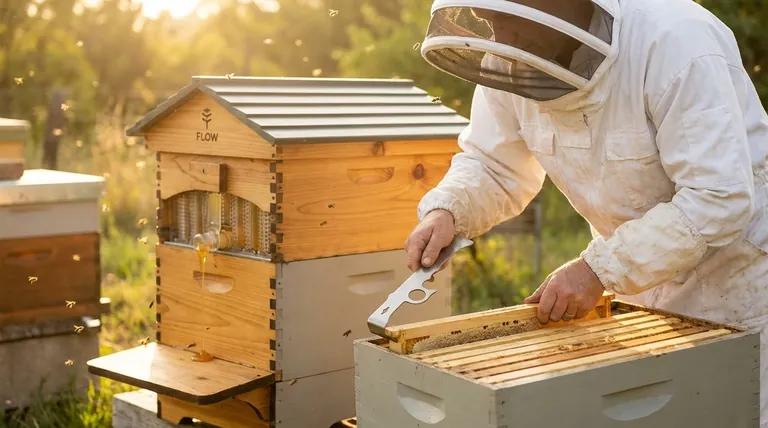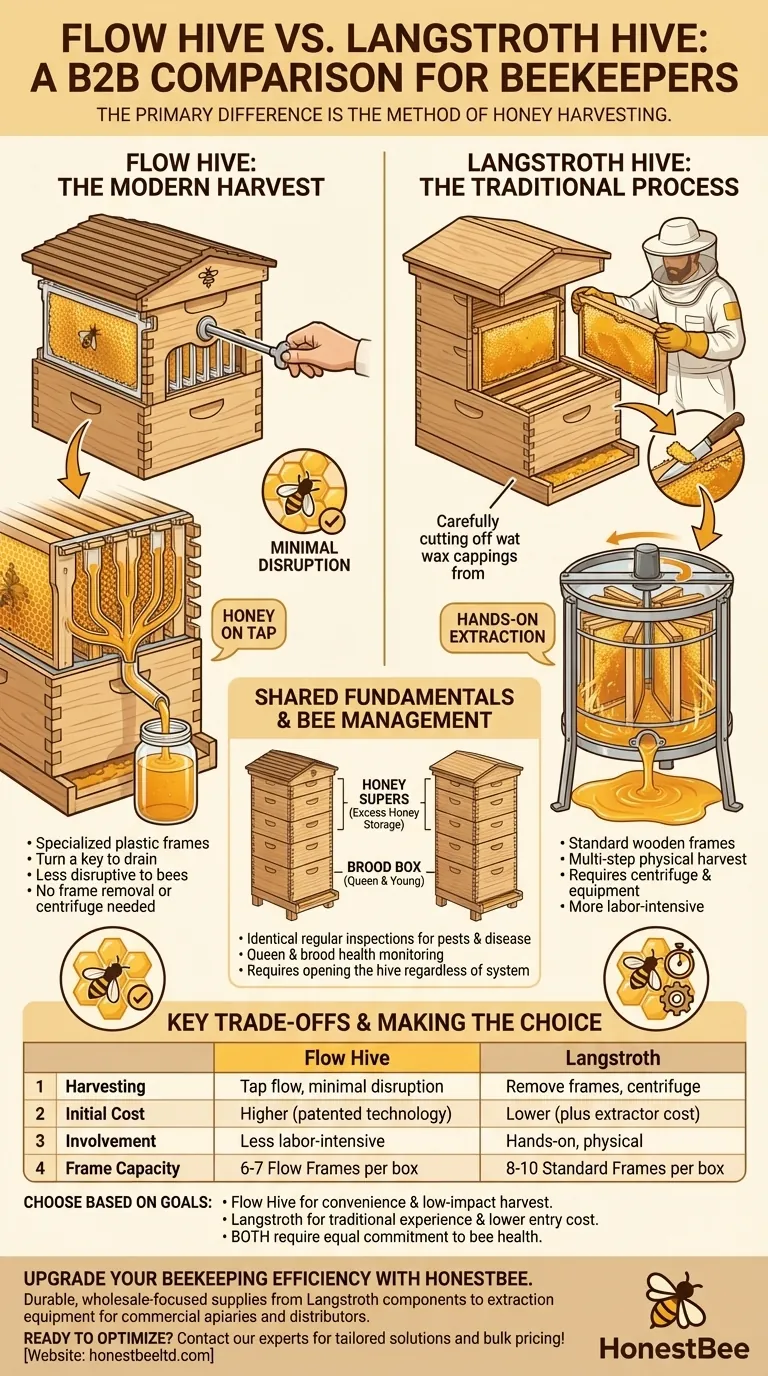The primary difference between a Flow Hive and a Langstroth hive is the method of honey harvesting. A Flow Hive uses specialized plastic frames that allow honey to be drained directly from the hive by turning a key, while a traditional Langstroth hive requires the physical removal of frames for honey to be extracted with separate equipment, like a centrifuge.
The decision between a Flow Hive and a Langstroth hive is not about which is superior for the bees, but about balancing the beekeeper's desire for harvesting convenience against the initial cost and a more traditional, hands-on beekeeping experience.

The Core Difference: Honey Harvesting
The most significant innovation of the Flow Hive is its unique harvesting process. This distinction shapes the entire experience for the beekeeper.
The Flow Hive Method: "Honey on Tap"
The Flow Hive super contains injection-molded plastic frames with partially formed honeycomb cells.
When the beekeeper turns a special key, the cells split vertically inside the frame. This creates channels that allow the honey to flow downwards and out of the hive through a spout, directly into a jar.
This method is significantly less disruptive to the bees during the actual harvest, as the hive does not need to be opened or the frames removed.
The Langstroth Method: The Traditional Process
Harvesting from a Langstroth hive is a multi-step, hands-on process.
The beekeeper must open the hive, remove the heavy honey-filled frames (called supers), and transport them to a separate area.
Each frame's wax cappings must be cut off before the frames are placed in an extractor (a centrifuge), which spins the honey out. This process requires a significant investment in additional equipment and is more disruptive to the colony's routine.
Hive Structure and Management
While the harvesting is different, the fundamental structure and the day-to-day management of the bees are remarkably similar.
Foundational Similarities
Both systems use a vertical, modular design. They have a brood box at the bottom where the queen lays eggs and the colony raises its young.
Honey supers are added on top of the brood box for the bees to store excess honey.
Frame and Box Compatibility
The Flow Hive was designed to be compatible with standard Langstroth dimensions. This means you can place a Flow Super on top of a standard Langstroth brood box.
However, the specialized Flow Frames are wider than traditional Langstroth frames. Because of this, a standard 10-frame Langstroth box will only fit 6 or 7 Flow Frames.
Understanding the Trade-offs
Choosing a hive system involves weighing convenience against cost and the level of involvement you desire.
Initial Cost vs. Long-Term Investment
A complete Flow Hive setup has a higher upfront cost due to its patented frame technology.
A Langstroth hive is cheaper to start with, but you must factor in the future cost of honey extraction equipment, which can be expensive.
Beekeeper Involvement
The Langstroth hive requires a more physical, hands-on approach to harvesting, which many traditional beekeepers enjoy as part of the experience.
The Flow Hive greatly simplifies the harvesting process, making it less labor-intensive and removing the need for heavy lifting.
A Critical Note on Bee Management
It is a common misconception that a Flow Hive requires less work overall. This is untrue.
Both hive types demand identical, regular inspections to monitor for pests (like varroa mites), check for disease, and ensure the queen and brood are healthy. This crucial management task involves opening the hive and removing frames from the brood box, regardless of the system you use.
How to Make the Right Choice
Your beekeeping goals should guide your decision. There is no single "best" hive, only the one that is best for you.
- If your primary focus is convenience and a low-impact harvest: The Flow Hive's innovative system is specifically designed to minimize the labor and disruption of honey collection.
- If your primary focus is a lower initial cost and a traditional, hands-on experience: The Langstroth hive is the time-tested industry standard that immerses you in every aspect of the craft.
- If your primary focus is bee health and colony wellness: Both hives require the exact same level of diligent inspection and care to ensure a thriving colony.
Ultimately, your choice depends on how you want to interact with the harvest, not the day-to-day management of your bees.
Summary Table:
| Feature | Flow Hive | Langstroth Hive |
|---|---|---|
| Honey Harvesting | Honey flows via tap; minimal bee disruption | Frames removed; extracted with centrifuge |
| Initial Cost | Higher due to patented frames | Lower, but requires extractor investment |
| Beekeeper Involvement | Less labor-intensive harvest | Hands-on, traditional experience |
| Frame Compatibility | Specialized plastic frames (6-7 per super) | Standard wooden frames (8-10 per super) |
| Bee Management | Identical inspection requirements for both hives | Identical inspection requirements for both hives |
Upgrade Your Beekeeping Efficiency with HONESTBEE
Whether you manage a commercial apiary or distribute beekeeping equipment, choosing the right hive is critical for productivity. At HONESTBEE, we supply durable, wholesale-focused beekeeping supplies—from Langstroth components to extraction equipment—helping you maximize honey yield and operational success.
Ready to optimize your setup? Contact our experts today for tailored solutions and bulk pricing!
Visual Guide

Related Products
- HONESTBEE Advanced Ergonomic Stainless Steel Hive Tool for Beekeeping
- Professional Dual-End Stainless Steel Hive Tool for Beekeeping
- Long Langstroth Style Horizontal Top Bar Hive for Wholesale
- Professional Galvanized Hive Strap with Secure Locking Buckle for Beekeeping
- Beehive Handle and Frame Rest Cutting Machine: Your Specialized Hive Machine
People Also Ask
- Why is it important to compare the progress of different hives? A Beekeeper's Key Diagnostic Tool
- What are the basic tools for beekeeping? Essential Starter Kit for Safe & Successful Hive Management
- How should beekeepers handle bees when using a hive tool? Master Calm, Deliberate Techniques
- What tools are used for cleaning frames? A Beekeeper's Simple 4-Tool Guide
- What are some common uses of a hive tool? Essential Multi-Purpose Tool for Every Beekeeper



















